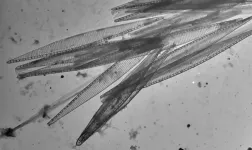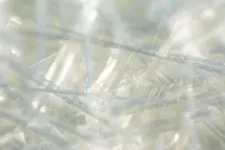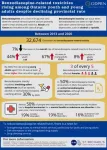Domoic acid can bioaccumulate within food webs, causing sickness and death in higher trophic level organisms such as marine mammals and birds, and have been documented in sea turtles in Florida coastal waters and in bull sharks within the Indian River Lagoon system. In humans, consumption of shellfish contaminated with domoic acid can cause harmful symptoms.
Unlike other harmful algal blooms, Pseudo-nitzschia are not bioluminescent and do not cause water discoloration or large fish kills. Because there are no obvious visual cues of these blooms and monitoring them is event based, documenting their presence is challenging.
Researchers from Florida Atlantic University’s Harbor Branch Oceanographic Institute have conducted the first widespread molecular study of domoic acid produced from Pseudo-nitzschia in the Indian River Lagoon. Their results, published in the journal Harmful Algae, suggest domoic acid may be a significant threat to the lagoon’s ecosystem.
To gain a better understanding of the ecology of Pseudo-nitzschia in the central and southern portions of the Indian River Lagoon system where monitoring has been less frequent, researchers collected surface water samples from five locations along the lagoon between October 2018 and May 2020. They analyzed 158 samples for phytoplankton concentrations via cell counts that were collected on 68 different dates. Scanning electron microscopy was conducted on cultured material, which enabled them to morphologically identify six distinct species of Pseudo-nitzschia and compare them with sequencing data.
Results showed Pseudo-nitzschia was present in 87 percent of the samples, which were associated with relatively high salinity waters and cool temperatures. All isolates demonstrated toxicity, and domoic acid was found in 47 percent of surface water samples. Although Pseudo-nitzschia concentrations were more prominent during the first half of the study, cells were often present at lower concentrations throughout the entire study period. Notable differences between the Indian River Lagoon system and other water bodies where Pseudo-nitzschia blooms occur include water temperatures, water clarity, residence times and salinity.
“The frequent presence of Pseudo-nitzschia, including bloom level concentrations, which we observed in our study, could lead to domoic acid integrating into the food web affecting shellfish, finfish, birds, sea turtles, dolphins, sharks, rays and humans,” said Malcolm McFarland, Ph.D., senior author and a research associate at FAU Harbor Branch. “As a nursery for many organisms, and supporting a high amount of biodiversity, the presence of domoic acid could negatively impact the biodiversity of the Indian River Lagoon system.”
In addition to a positive relationship with salinity, researchers also found that Pseudo-nitzschia had an inverse relationship with temperature. This suggests Pseudo-nitzschia in the Indian River Lagoon prefers cooler water temperatures for growth. Cell abundances of Pseudo-nitzschia were highest during the late fall, winter and early spring, when temperatures in the lagoon are cooler. Some of the highest abundances of Pseudo-nitzschia in the southern Indian River Lagoon system occurred at sampling sites with the closest proximities to inlets.
“Given the characteristics of the Indian River Lagoon system, such as warm water temperatures, high nutrients, and shallow depths, we think that Pseudo-nitzschia may be a resident population, that is, present year-round,” said Stephanie Schreiber, first author and a coordinator of research programs and services at FAU Harbor Branch. “Results from our study suggest Pseudo-nitzschia could be considered a key contributor to phytoplankton community composition in the southern Indian River Lagoon system as well.”
As one of multiple toxic harmful algal blooms-forming organisms within the Indian River Lagoon, understanding its distribution and population dynamics is critical to protecting biodiversity as well as human, animal and ecosystem health.
“Accurate identification methods are critical to determine the presence or absence of toxigenic species of Pseudo-nitzschia and to assess the potential threat posed by blooms of these algae,” said McFarland. “Although domoic acid is not present at all times in the southern Indian River Lagoon system, its frequent occurrence suggests it is an important toxin to monitor in the lagoon. Continuous exposures to domoic acid, even at low levels, may have unknown impacts on the lagoon system over time.”
Study co-authors are Dennis Hanisak, Ph.D., research professor; and Carlie Perricone, a graduate student; FAU Harbor Branch; Andia Chaves Fonnegra, Ph.D., an assistant professor of biology, FAU Harriet L. Wilkes Honors College; and James Sullivan, Ph.D., executive director, FAU Harbor Branch.
This project was funded through the Indian River Lagoon National Estuary Program (Contract Nos. IRL2018-02, IRL2019-24, and IRL2020-15) and the Center for Coastal and Human Health funded by the Harbor Branch Oceanographic Institute Foundation.
- FAU -
About Harbor Branch Oceanographic Institute:
Founded in 1971, Harbor Branch Oceanographic Institute at Florida Atlantic University is a research community of marine scientists, engineers, educators and other professionals focused on Ocean Science for a Better World. The institute drives innovation in ocean engineering, at-sea operations, drug discovery and biotechnology from the oceans, coastal ecology and conservation, marine mammal research and conservation, aquaculture, ocean observing systems and marine education. For more information, visit www.fau.edu/hboi.
About Florida Atlantic University:
Florida Atlantic University, established in 1961, officially opened its doors in 1964 as the fifth public university in Florida. Today, the University serves more than 30,000 undergraduate and graduate students across six campuses located along the southeast Florida coast. In recent years, the University has doubled its research expenditures and outpaced its peers in student achievement rates. Through the coexistence of access and excellence, FAU embodies an innovative model where traditional achievement gaps vanish. FAU is designated a Hispanic-serving institution, ranked as a top public university by U.S. News & World Report and a High Research Activity institution by the Carnegie Foundation for the Advancement of Teaching. For more information, visit www.fau.edu.
END


